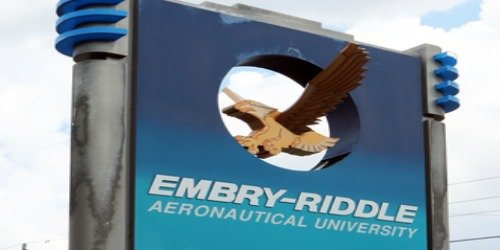
Daytona Beach, FL - Students at Embry-Riddle Aeronautical University (ERAU) in Daytona Beach have designed a Formula-style race car that they will continue building until its debut at an upcoming international competition in May.
Trevor Duffy, Jose Rodriguez, Jack Liggins, and Maxwell Kline are some of the ERAU students working on the race car.
“This is my favorite part,” said Kline, ERAU senior, team lead, competition driver, and president of the ERAU Motorsports Club. “You see it go from a piece of paper to a digital workspace where you design and do all your simulations and then to the physical world.”
The students’ race car will compete at the upcoming Formula SAE (Society of Automotive Engineers) series competition in May at the Michigan International Speedway. The competition will feature 120 teams from around the world. 40 ERAU undergraduate and graduate students will have spent nine months designing, constructing, testing, and racing an open-wheel style high-performance vehicle to compete with.
Everything except for a Honda 600 cc liquid-cooled inline four-cylinder engine is designed and manufactured by the student competitors. Students will also create a business plan and cost analysis for a 1,000-unit production run of their race car. At the competition, awards for fuel efficiency, innovative use of technology, endurance, acceleration, analytical approach to design, and overall dynamic performance will be given out.
David Spitzer, a staff research engineer for ERAU’s Center for Motorsports Engineering, said the upcoming competition is widely known in the engineering industry. As an engineering student at Cornell University in the early 1990s, Spitzer competed in Formula SAE. Before coming to ERAU in 2014, Spitzer was a professional auto racer. Spitzer lauds the competition because it helps students land internships and jobs because it shows that they can work in teams to overcome challenges.
“In the classroom setting, assignments are neat and tidy. Questions are simplified and an easy solution can be found,” said Spitzer. “But in the real world, it’s not like that. It’s really complex. One of the skills an engineer must learn is how to think things through and look at all aspects of a problem, such as strength, heat, friction, dimensional tolerance, and material choice. Often, they have to make their own assumptions to find a solution.”
This year, students are experimenting with using a lighter carbon fiber material for various parts of the car to improve speed and efficiency. Other improvements to the car include changes to the composite design, fabrication process, powertrain, and braking systems.
“It is very fast paced,” said assistant professor of mechanical engineering and the team’s co-advisor, Rafael Rodriguez. “They are making decisions based on good engineering judgment. This is the type of experience companies are looking for.”
According to ERAU, some graduates work in motorsports, but many go on to work in engineering and aerospace. December 2016 graduate of mechanical engineering Alexander Hurd is now a manufacturing engineer with Haas Automation in Oxnard, California. Hurd designs tools for assembly on the shop floor as well as he maintains work instructions, sustains and troubleshoots on the assembly lines, and makes improvements to assembly processes and products.
“The Formula team simply showed me how multi-talented and dedicated you need to be in order to be a successful, cutting-edge engineer,” said Hurd.
Bill Wanstall, ERAU alumnus, is an IndyCar support engineer for Pratt & Miller Engineering. Wanstall said the Formula competition opened him up to different kinds of engineering and prepared him for the fast pace of the motorsports industry. He provides A.J. Foyt Racing with software support, expertise on tools created by Pratt & Miller, vehicle dynamics evaluation and simulation, development of data analysis methods, and ensuring vehicle performance.
“The tools required, analysis techniques used, and tight time and budget constraints make the competition a perfect stepping stone for those looking for the experience necessary to break into the world of motor racing,” said Wanstall. Wanstall has a bachelor’s in mechanical engineering and is hoping to finish his master’s degree from ERAU in May.
Maxwell Kline has participated in the competition for four years. After graduation, he will work a summer internship with an automotive company that manufactures race cars. He will return to ERAU for a master’s in mechanical engineering. He hopes to design race cars for a living. Kline is one of the drivers in the upcoming competition. The car accelerates from zero to 60 in three seconds and travels at 75 miles per hour.
“You are always pushing the car to its limits,” Kline said.
“It’s such an amazing thing knowing how much blood, sweat, and tears goes into building the car [for the competition] and then you’re able to see it go around the track,” said Kyle Morris, a mechanical engineering senior concentrating in high-performance vehicles. This year, Morris is leading suspension. Participating in Formula SAE has helped Morris with job interviews in the automotive industry.
“Since I was a little girl, I have always loved motorsports and I wanted to further my passion by joining ERAU Motorsports,” said Asia Hirschenson, who graduated with a bachelor’s in business administration this past fall. She leads the team’s marketing and corporate communications.
Photo courtesy jamesrmartin and Shutterstock.com.
Copyright Southern Stone Communications 2018.